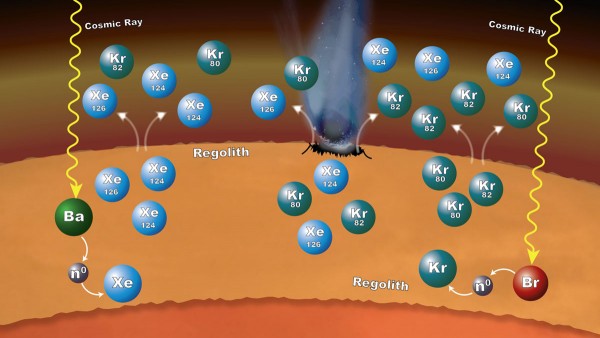By Ana Verayo, | October 02, 2016

Processes in Mars' surface material can explain why particular xenon (Xe) and krypton (Kr) isotopes are more abundant in the Martian atmosphere than expected, as measured by NASA's Curiosity rover.
NASA's Mars Curiosity rover has collected evidence indicating that the surface of the Red Planet is directly changing its tenuous atmosphere. The evidence was detected by the Sample Analysis at Mars (SAM) Instrument Suite of the rover.
Like Us on Facebook
The rover analyzed xenon and krypton isotopes found in Mars' atmosphere, and mission scientists compared these isotopic measurements to the first NASA mission to Mars, the Viking mission.
During the evolution of Mars, its atmosphere experienced a mysterious, slow disappearance. Thousands of years--probably millions-ago, Mars' atmosphere was almost similar to Earth's. However, solar wind has stripped away most of its atmospheric gases.
This new study reveals that the data collected by Curiosity and the data from the Viking mission are slightly different, revealing changing isotopic ratios.
What are isotopes? An isotope consists of a certain number of neutrons. These neutrons, which transfer between the elements found in the soil of Mars, can hold clues about the changing isotope ratios in Martian atmosphere.
Meteor impacts are believed to have released these unique isotopes from exposed soil and rock material into the atmosphere.
According to SAM's principal investigator, Pamela Conrad of NASA's Goddard Space Flight Center, these measurements are evidence of an interesting and crucial process where rock and other material from Martian surface have contributed xenon and krypton isotopic compositions into the atmosphere.
According to Michael Meyer, a lead scientist with NASA's Mars Exploration Program, this unique ability of the rover to measure six to nine different isotopes of krypton and xenon can allow scientists to study these complex interactions between the crust and the surface of Mars and ultimately its planetary evolution.
This new study has been published in the journal Earth and Planetary Science Letters.
-
Use of Coronavirus Pandemic Drones Raises Privacy Concerns: Drones Spread Fear, Local Officials Say

-
Coronavirus Hampers The Delivery Of Lockheed Martin F-35 Stealth Fighters For 2020

-
Instagram Speeds Up Plans to Add Account Memorialization Feature Due to COVID-19 Deaths

-
NASA: Perseverance Plans to Bring 'Mars Rock' to Earth in 2031

-
600 Dead And 3,000 In The Hospital as Iranians Believed Drinking High-Concentrations of Alcohol Can Cure The Coronavirus

-
600 Dead And 3,000 In The Hospital as Iranians Believed Drinking High-Concentrations of Alcohol Can Cure The Coronavirus

-
COVID-19: Doctors, Nurses Use Virtual Reality to Learn New Skills in Treating Coronavirus Patients







